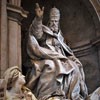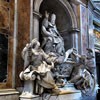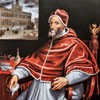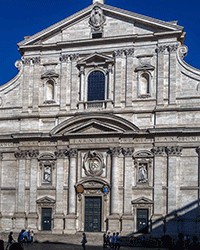Pope Gregory XIII (1502–1585) – a tireless counter-reformer and an efficient reformer of the calendar

Tombstone of Pope Gregory XIII, fragment, Basilica of San Pietro in Vaticano

Bust of Pope Gregory XIII, Casino Ludovisi

Portrait of Pope Gregory XIII, Casino Ludovisi

Basilica of San Pietro in Vaticano, dome decoration

Tombstone of Pope Gregory XIII, Basilica of San Pietro in Vaticano

Tombstone of Gregory XIII, fragment, decorative relief completed by Francesco Mellone, Basilica of San Pietro in Vaticano

Tombstone of Pope Gregory XIII, Basilica of San Pietro in Vaticano

Portrait of Pope Gregory XIII, unknown painter, in the background the work of the pope – Gregoriana

Dragon – element of the Boncompagni coat of arms in front of the enterance to the Gregoriana

Ponte Rotto, bridge rebuilt by Pope Gregory XIII, in the decorations elements of the pope’s coat of arms
In 1572, after a short, lasting a mere 24 hours conclave, a Bolognese cardinal with bourgeoisie roots was elected as the new pope. Such a hasty decision of the cardinals was caused by the resignation of the principal favorite Alessandro Farnese, who at the behest of a skilled political player of the time – the King of Spain Phillip II – gave way to a little-known, but highly valued by the Spanish ruler clergyman. Why?
In 1572, after a short, lasting a mere 24 hours conclave, a Bolognese cardinal with bourgeoisie roots was elected as the new pope. Such a hasty decision of the cardinals was caused by the resignation of the principal favorite Alessandro Farnese, who at the behest of a skilled political player of the time – the King of Spain Phillip II – gave way to a little-known, but highly valued by the Spanish ruler clergyman. Why?
They both met in Spain, when cardinal Boncompagni was the papal legate there. In him Phillip saw not only an able lawyer and an politician but also an ally in his fight against the Reformation, who will not hesitate to defend the Catholic faith both with sword and with word. The king was not let down by „his” pope, who in all sense of the word was a counter-reformer pope and during his thirteen-year long pontificate attempted to weaken and when possible put down – the spirit of Protestantism in England, Ireland, France and the German lands. It should come as no surprise, that the pope expressed his joy at the slaughter committed in Paris on the Night of St. Bartholomew in 1572, where thousands of French Huguenots died, by holding a thanksgiving service, while he ordered his apartments to be decorated with frescos depicting this brutal massacre (the artist responsible for this commission was Giorgio Vasari himself). He also ordered a medal to be minted to commemorate and illustrate this event.
The battle against infidels was the principal slogan of the pontificate of Gregory XIII, and his most able aides turned out to be the Jesuits. The pope sent them to every corner of Europe threatened with Reformation, but also to India, Japan and Brazil. The center in this struggle against heresy and paganism was the Roman College (Collegium Romanum), established during the times of Ignatius Loyola. The pope raised its status to that of papal university, henceforth known as Gregoriana (from the pope’s name).

Despite trying the pope was not successful in beheading the hydra of Protestantism, but he did defeat it in one dimension. Gregory XII is remembered in history chiefly as the pope who introduced a new calendar – known from his name as Gregorian. However, his success was not so much modernizing the previously used Julian calendar, but forcing its use on his mortal enemies – followers of Protestantism. This fact had as great of significance as did the acceptance into the womb of the Church, of a Protestant – Christina, the Queen of Sweden. And so it was that in the year 1582 the pope ordered 10 days to be removed from the calendar – October 4th was immediately followed by October 15th and all of Europe agreed. We can talk of a spectacular victory of the pope on the world stage. It is greater still, since it was not so obvious and Rome assumed that a different calendar may be in use in Catholic countries than in Protestant countries. The situation could have been similar to Orthodox Russia, which did not accept the reform and all the way until the October Revolution in 1917 (which in Russia took place in November) the Catholic order of the world was not adhered to.
The pope who assumed the throne of St. Peter at the age of 70 years old, possessed the spiritual and mental characteristics of a young man. Perhaps that is why his expenses were extraordinary. In part they were used for artistic projects, in which he concentrated on grandeur and the highest quality of materials; another part was used for private purposes. Ascending to the papal throne, Gregory officially recognized his son Giacomo, who assumed the post of Castellan of The Castle of the Holy Angel in Rome, but in order to ensure him the appropriate status after his own death, he purchased the Marquisate of Vignola for him, and then the Duchy of Sora. The constantly empty treasury was filled by the pope by controversial decisions such as retracting his decision to remit all debts of the aristocracy and confiscation of the estates of merchants and nobility.

The pope planned to have his final resting place as well as that of his two nepots in a chapel specifically decorated for that purpose, known as Gregoriana in the Basilica of St. Peter (San Pietro in Vaticano). In the end his tomb was placed outside the chapel. Its form was also changed to be more representative, since it seemed too modest for the Boncompagni family (Funerary monument of Pope Gregory XIII). The designer and the artist for the new statue, which was not finished until 1723, was the well-known and valued sculptor of that time Camillo Rusconi, the author of among others, the monumental figures of the disciples from the Basilica of St. John in Lateran (San Giovanni in Laterano). The tombstone figure of Gregory is a composition made up of the figure of the pope in a gesture of blessing, made of white marble, as well as two allegoric figures – Faith with Bible and a tablet, on which there is a Latin inscription: „I know your works, your love, faith, service, and endurance, and that your last works are greater than the first", and Fortitude depicted as Minerva lifting a curtain. Behind this curtain there is a sarcophagus, of which the lid is decorated with the scene of a meeting of the Head of the Church with mathematicians and scientists, devoted to the aforementioned modernization of the calendar. The dragon depicted in the central part of the sarcophagus is a connection to the heraldic figure from the pope’s coat of arms of the Boncompagni family. The tombstone was funded by Cardinal Giacomo Boncompagni. He did not shy from explicitly pointing it out – the inscription placed on the face of the tombstone praises both the accomplishment of the pope as well as his grandnephew. The dedication once again shows the importance, of commemorating the deceased – it was not only a sign of honoring him, but also a means serving to nobilitated the family, providing splendor and significance to the family name.

The most important structures built thanks to the patronage of Gregory XII:
The Apostolic Palace
- Tower of the Winds – papal astronomic observatory decorated with frescos by Pomarancio (Niccolò Circignani), 1580
Basilica of San Pietro in Vaticano
- Decoration of the dome with mother-of-pearl, gilt-bronzes, mosaics and semiprecious stones, decoration of the Gregorian Chapel (Cappella Gregoriana); it was at the time considered the most decorative and the most valuable as far as selection of materials in all of the basilica – it is covered with carpeting from mother-of-pearl and various marbles.
Palazzo Quirinale
- Expansion and reconstruction of the palace to be used as a summer residence by the pope































